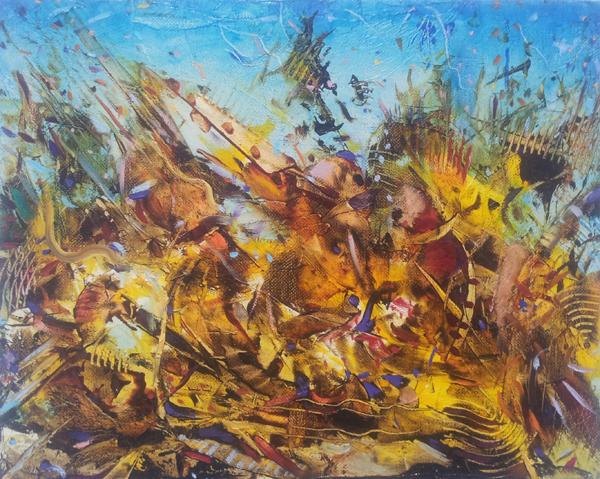Blain/Southern presents ‘At Once’, an exhibition of oil paintings created over the last two years by New York-based artist Ali Banisadr. This is his first-ever solo show in the UK and includes a 7-metre long triptych, the artist’s largest work to date. The nature of Banisadr’s work is attributable to the synaesthesia he experiences while painting. This began when he was a child growing up in Tehran during the Iran-Iraq war, where he drew the sounds of bombing and air-raids to make sense of what was happening. These create highly subjective paintings if not for the hybridised and homogeneous art historical nature of the work.
Figuration and Abstraction blur and collide in a conflagration of swirls in the artist’s paintings. The works are strangely a little reminiscent of a previous artist at Blain/Southern, highlighting the gallery’s particular taste. Jonas Burgert’s recent paintings at the gallery presented a menagerie of contorted fantastical sights in the artist’s trademark fluorescent colours – a collection of acid yellows, electric blues, purples, pinks and reds, as if a paradigm of frozen moments from a deranged Grimm Brothers’ fairytale, the difference being a prominence of figuration.
With Banisadr we have the delicate manipulation of the figure into abstraction, and the nature of abstraction, pushed to resemble the figure. The New York artist uses a similar colour range to his German counterpart, but Banisadr’s work is also more about the process of painting in very much the same was as say the Abstract Expressionists – in that it recognises the nature of painting itself as the primary concern of the artist.
In the work there is also a vibrancy of colour that insinuates the unreality of the image before us; much like Bugert, and Romanian painter Adrian Ghenie – all seem to push away from reality with fantastical imagery which then lapses back to nightmare. In fact there are a number of contemporary painters out there proving that painting still has a relevance, an understanding of history, and how the nature of the 21st century photographic image has effected painting, re-invigorating its worth. For example the British painter Justin Mortimer creates Baconian nightmares of fetishistic flesh; a psychological mise en scene of necrotic hues, frail bodies, victims of some amoral goya-esque performance on some sort of hallucinogenic compound administered with candy, but the work also references art history and draws on imagery found on the internet, and effects resulting from digital technology.
Banisadr’s fusing of abstraction and figuration also takes some visual cues from the blurring of digital imagery, perhaps mixed with that blurred ‘flicking’ Baconian head to be found in our imaginations more that it can be found on the actual canvas. In turn the artist creates images highly reminiscent of another horror; Banisadr’s works are like Bosch’s ‘The Garden of Earthly Delights, re-worked as an abstract, but still insinuating figurative elements of the original.
It has to be said that the colours of Pieter Bruegel’s ‘Netherlandish Proverbs’ 1559 (above) are also in the mix somewhere – the vividness of the work is partly accounted for by the synaesthesia the artist has experienced since childhood – Banisadr’s art-historical inspirations are quite apparent; Persian miniaturists, Kandinsky, Marinetti,Veronese, Richter, alongside a range of literary influences, as well as contemporary motifs drawn from comic books, films and music – again we see another possible colour influence, although I never thought I would ever juxtapose Bruegel with Marvel.
The artist’s scenes are ambivalent, a vibrating conflagration of ‘non-figuration’ that could be a battle, or a bacchanal. The artist’s images are in a perpetual state of dissolve. Banisadr’s paint is in flux, forever in movement; at once figures and swirling expressive brushstrokes, finding an exact middle-ground between the two.
Banisadr’s veiled figuration are hybrids of human, and animal, machine, mythology, smudged into a frenzy of abstraction. The artist’s use of paint is genuinely synaesthetic, like painting the colour of a particular smell, or the line of a sound, Banisadr’s homogenised senses attempt to create all by enabling the paint to express everything simultaneously. The artist’s painting could never be one thing.
Ali Banisadr: At Once – Blain Southern, 4 Hanover Square – until 21 March 2015
Words: Paul Black Photo: P A Black © Artlyst 2015 all rights reserved

